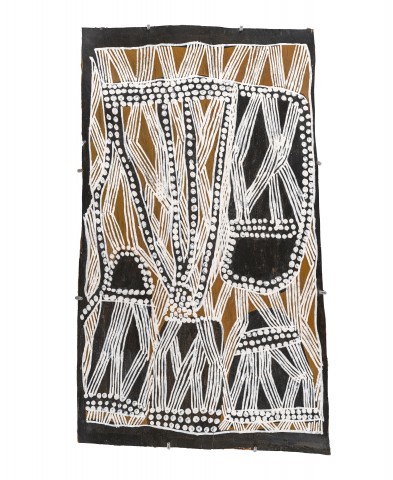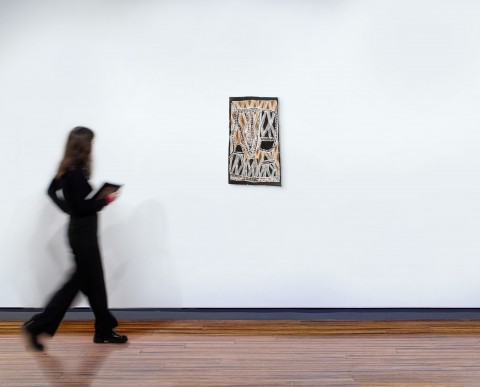BARATJALA, 2015
NOŊGIRRŊA MARAWILI
natural earth pigments and recycled print toner on eucalyptus bark
74.5 x 44.0 cm (irregular)
bears inscription verso: Buku–Larrŋgay Mulka Centre cat. 4816-U
bears inscription on label verso: artist’s name and Buku–Larrŋgay Mulka Centre cat. 4816-U
Buku-Larrŋgay Mulka Centre, Yirrkala, Northern Territory
Buku-Larrŋgay at the Darwin Art Fair, Darwin
Private collection, Brisbane, acquired from the above
This work is accompanied by a certificate of authenticity from Buku–Larrŋgay Mulka Centre which states:
'Baratjula is a Madarrpa clan estate adjacent to Cape Shield where the artist camped with her father and his many wives as a young girl. She lived nomadically as part of a clan group with a flotilla of canoes between Groote Eyelandt and the mainland. Her father's name was Mundukul (lightning snake) and this is also the name of the serpent (also known as Water Python, Burrut'tji or Liasis Fuscus) which lives deep beneath the sea here. Some of the designs show the rock set in deep water between the electric 'curse' that the snake spits into the sky in the form of lightning, and the spray of the sea trying to shift the rock foundation of the Madarrpa. Yurr'yunna is the word used to describe the rough waves over-topping the rock and the spray flying into the sky. This journey from the sacred to the descriptive shifts even further where she uses her mark making to portray more anonymous natural features of her landscape such as drying billabongs in the flood-plains of cracking mud. Her identity cannot be separated from her art and so although she disavows any sacred intent the echo of miny'tji persists.'
Noŋgirrŋa Marawili’s Baratjala, 2015, abounds with the energy of her coastal lands. Dark forms of rocks, painted in ochre and charcoal, are outlined in white dots and contained by an overlay of irregular parallel lines of smaller dots, evoking the rhythm and cyclical interactions of currents, tides and breaking waves. In recording adjacent sites of Yathikpa and Baratjala, located on Blue Mud Bay, Marawili asserts the secular nature of her painting, ‘I paint water designs – the water as it splashes onto the rocks at high tide…. the painting that I do is not sacred…. The paintings I do are from the outside, Water, Rock, Rocks which stand strong and the waves which run and crash upon the rock, the Sea spray. This is the painting I do, but I know the sacred designs.’1
Marawili began painting in the 1990s as an assistant to her husband, Djutjadjutja Munuŋgurr, adding cross-hatching and in-fill according to his instructions, and over the next decade she would collaborate with him following established Yolŋu bark painting conventions. Marawili didn't begin to emerge in her own right until 2005 when she became a regular painter at Buku-Larrŋgay, but her most original works appeared from 2011 when she began to paint interpretations of her paternal lands. Her current work refers back to these areas, remembering ancient ways of living directly on country she grew up on as a child.
Marawili’s work has been the recipient of a number of awards, winning the NAATSIA Best Bark award in 2015 and again in 2019, and she has been the subject of a major solo exhibition at the Art Gallery of New South Wales in 2018. Her paintings were also included in major group exhibitions, such as Tarnathi, Art Gallery of South Australia in 2019; NIRIN, Biennale of Sydney in 2020; Know My Name, National Gallery of Australia; and Bark Ladies, National Gallery of Victoria run over the summer of 2021 – 2022.
1. Pinchbeck, C. (ed.), Noŋgirrŋa Marawili. From My Heart and Mind, Art Gallery of New South Wales, Sydney, 2018, p. 21
CRISPIN GUTTERIDGE

